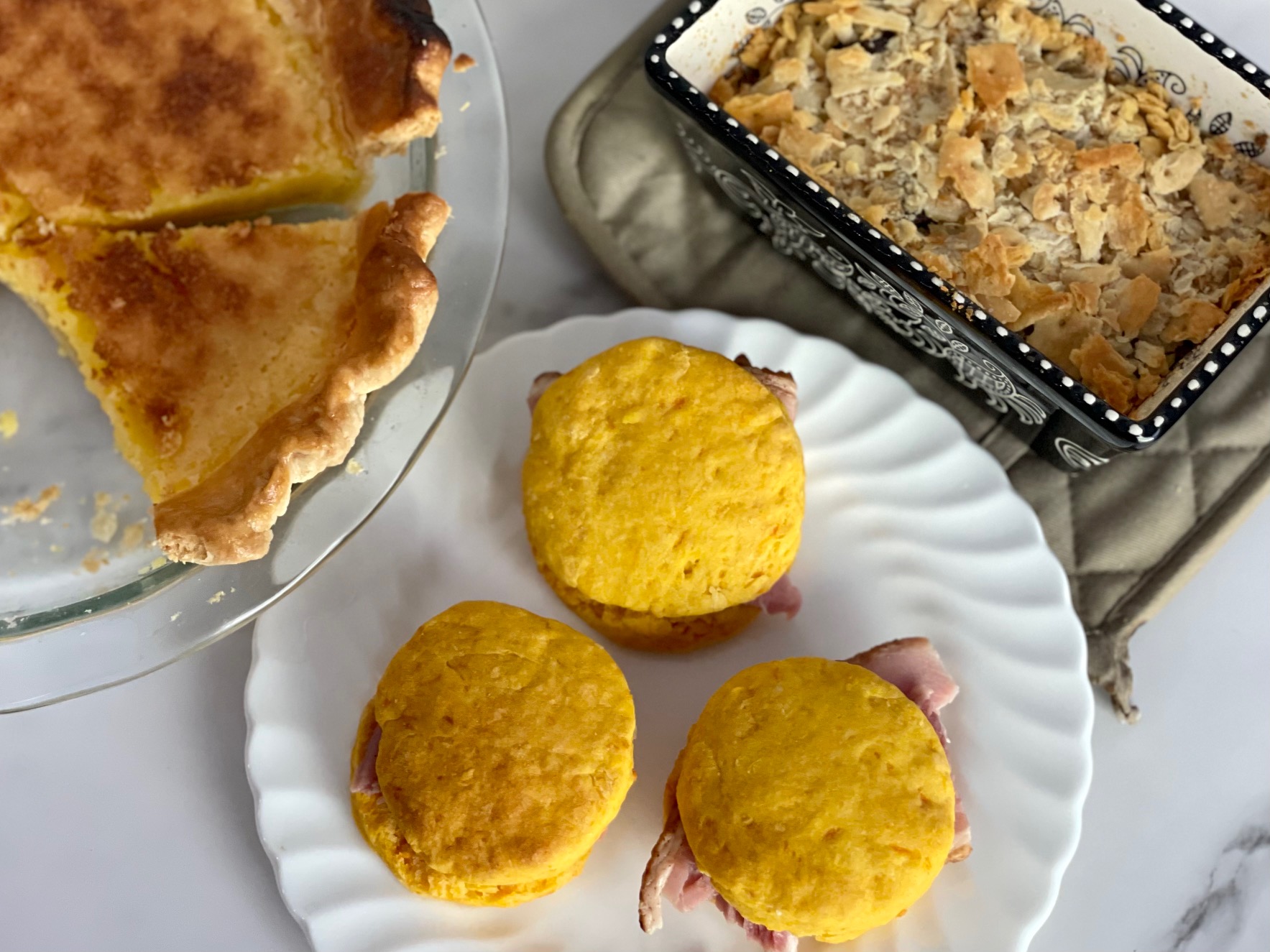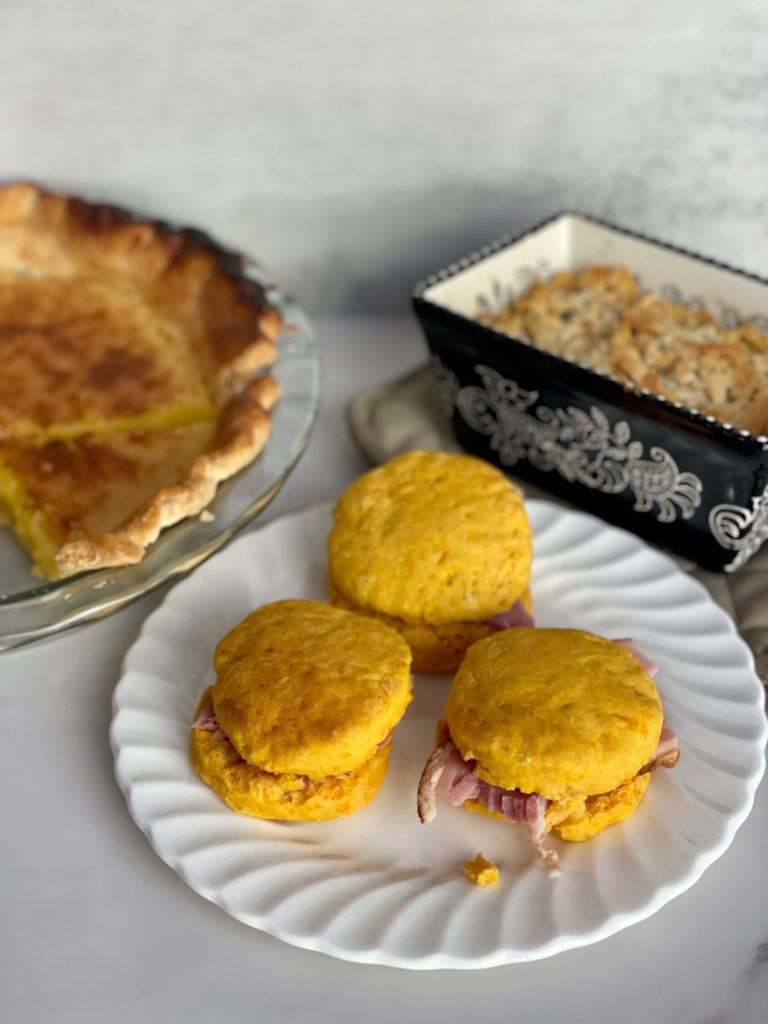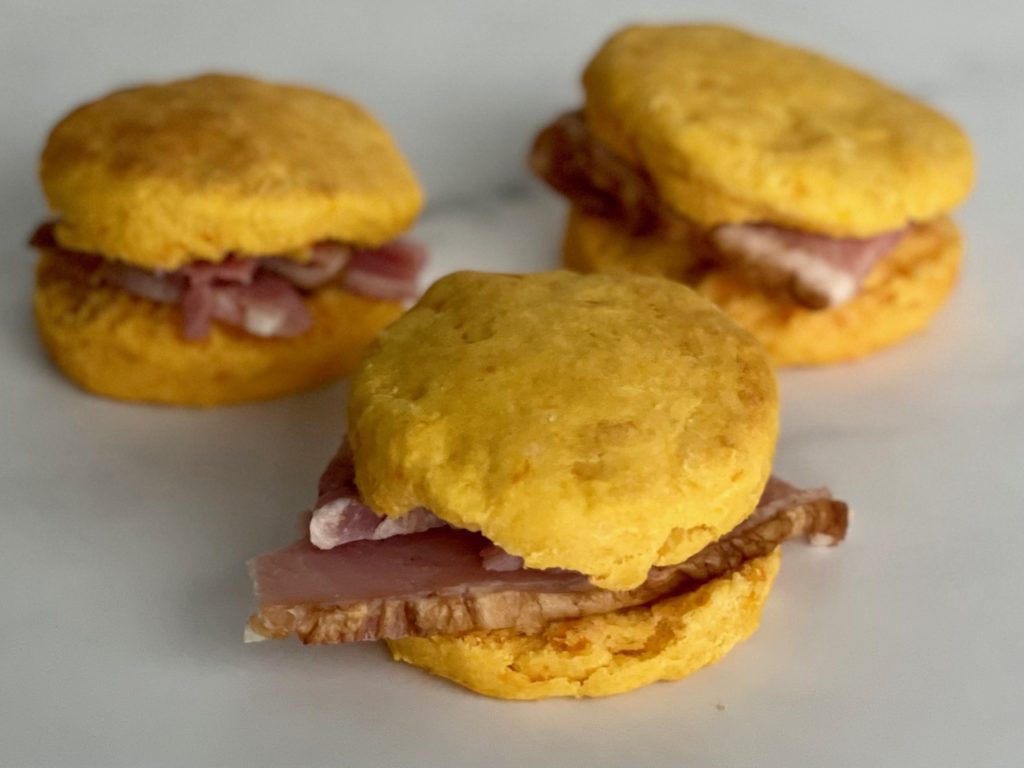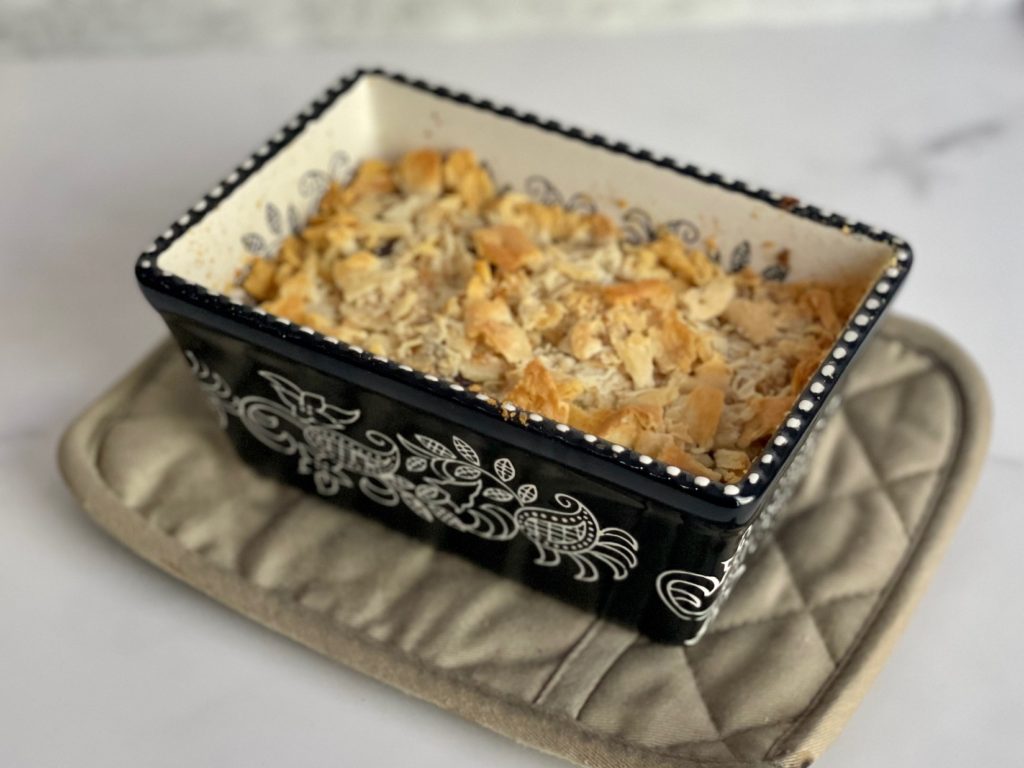Inspired by Virginia

THE MEAL
(Click on the links above to jump to that part of the post!)
Virginia is basically the birthplace of what became the United States of America. The first English colony was Jamestown in what is now Virginia, and many of the Founding Fathers were from Virginia—most notably George Washington, Thomas Jefferson, and James Madison.
And yet, none of the foods I made for this meal were anything I’d ever even heard of before this challenge, let alone eaten. You’d think that the culinary traditions that started and continue to exist in Virginia would’ve become American staples, but you’d be wrong!
SWEET POTATO BISCUITS WITH HAM
Okay so of course I’ve had ham on rolls before. That’s almost a mandatory meal in Utah open houses. But I had never (and still have never) had a Virginian country ham, and I’d never had sweet potato biscuits before.
Cured ham is a big deal in Virginia. The original settlers of Jamestown brought razorback pigs with them, and pork became one of their primary exports to other colonies and back to Europe. They combined European and Native American techniques to cure their meat, which lasted longer and traveled better than other foods. Virginia is uniquely situated in the perfect climate for curing hams. Any hotter, and the ham would rot; any colder, and it would freeze. The cured hams from Virginia were hugely popular with the Founding Fathers and later with Queen Victoria, who it’s said used to order six Virginia hams per week! Hams are traditionally eaten around Easter time because the hogs were butchered in the winter, then cured for months, and were ready to eat in the spring!
A Virginia ham is also referred to as a “country ham.” It’s dry-cured, smoked, and aged to add tons of flavor. Before eating a true country ham, you first need to soak it to get rid of some of the saltiness, and you also have to scrub it to remove the layer of mold that forms during the aging process. Yummm…
Smithfield, Virginia, is called “the Ham Capital of the World.” A true Smithfield Ham MUST originate in Smithfield, similar to how champagne has to actually come from Champagne, France, to be authentic.
Another random factoid I learned about Virginian ham: the world’s oldest cured ham is currently displayed in the Isle of Wight Country Museum in Smithfield. It is over 115 years old!!!
Anyway, I didn’t get a real country ham, obviously. They are EXPENSIVE. I didn’t even buy my own ham for this meal—I stole some from my family’s Easter feast and used it later when cooking for myself. 🙂

Ham on biscuits is a beloved meal in Virginia, and I decided to go an extra step and make sweet potato biscuits to incorporate another Virginian staple food.
Though sweet potatoes originated in South America, they’re thought to have been first cultivated in Virginia. They grow really well on Virginia’s Eastern Shore. They’re nutritious and easy to store, making them an important crop in the colonies. North Carolina now grows the most sweet potatoes, but they’re very popular in Virginia too.George Washington grew sweet potatoes on his farm before he became a Revolutionary general and politician. I don’t know when sweet potato biscuits were first invented, but Thomas Jefferson apparently loved them, and his recipe has been preserved! I didn’t use it, but it’s pretty cool! Here it is: https://www.food.com/recipe/thomas-jeffersons-sweet-potato-biscuits-1774-318826
These biscuits turned out really good! I love using sweet potatoes and pumpkin in bread, so I had a hunch I would like them. They were light but chewy and slightly sweet from the potatoes. They tasted great with ham! Nice complementary flavors. And they naturally split down the middle on their own when baked, so that made them handy for eating!
I love classic buttermilk biscuits, but this a fun and delicious alternative!
OYSTER PIE
So if you follow me on Instagram, you might remember that I had a hard time coming up with a side dish for this meal. Thankfully, my awesome followers pulled through and gave me several great suggestions, with this one fitting the bill of being something utterly unique and beloved in the Virginia area.
Virginia is famous for oysters. They’d been harvested by Native Americans in the region for thousands of years, and the colonists relied on them as a staple of their diet. From Virginia, they were canned and spread in popularity throughout the United States and Europe, to the point that the oyster population was almost entirely eradicated in the 1970s before conservation efforts brought them back around. Even now, wild oysters are only at 1% of their historical population, which sucks because oysters filter water and are essential to healthy ocean ecosystems. Anyway, oysters have been used in all different kinds of recipes in Virginia (including ice cream???). A favorite dish at Virginian Thanksgivings is known as oyster pie.
And I absolutely DREADED making it.
I’d never had oysters before. And I live in Utah, so I knew that finding GOOD oysters was going to be difficult. The thought of making and eating this pie is part of the reason why I took so long to make this meal even though I wasn’t especially busy in April.
I couldn’t manage to take a picture of the inside of this little casserole without it looking absolutely revolting, so all you get is a view from the top, sorry. Basically, the dish is just crushed soda crackers layered with shucked oysters, then you drizzle some milk and butter over the top and bake it until the top is crispy.
The oysters I used weren’t fresh or even just plain shucked oysters in a can. All I could find was tinned smoked oysters. Definitely wrong, I know, but I saw that you can use smoked oysters in other kinds of meat pies, so I figured it was close enough to the concept. Let’s be real: I could’ve done better. But I didn’t want to shell out (ha) for expensive seafood to use in a dish I was 99.9% sure was going straight in the trash.
I didn’t expect the oysters to look like tiny hearts when I opened up the tins. It was honestly quite scary. My stomach roiled at both the look and the fishy smell, and I almost retched just at the thought of having to eat it. I thought FOR SURE I was going to take one bite, then puke, then throw the rest away.
But I soldiered on. I wanted to do the Virginians proud.
And to my complete and utter shock, I didn’t hate it!
Not only did I not hate it, but my fork immediately went back for another bite, then another, and another! I didn’t much like the fishy aftertaste, but the oysters had a very nice, tender texture without being at all chewy like I was afraid of, and the salty, smoky flavor was kind of addicting. When Googling canned oysters, I saw that they’re commonly eaten on crackers. So this was like that same concept, but as a layered casserole instead of an hors d’oeuvre. Not bad at all!
So if you’re feeling REALLY adventurous (or already know you like oysters and/or have fresh oysters near you), this is worth trying out!
LEMON CHESS PIE
You guys.
It finally happened.
I made a real pie. With a real pie crust. From scratch.

My pie crust was flaky and buttery and delicious, and the filling is one of my new favorite things. You already know I love lemon. I love lemon bars. This pie was like lemon bar pie! It had that custardy texture with the slightly crusty top, that punch of citrus, mm! *Chef’s kiss*
Lemon chess pie is a variation of a classic Virginian dessert recipe that goes back to before the Revolutionary War. Similar desserts have existed in England for ages, and Martha Washington had a cookbook with a recipe for what seemed like a chess pie. Chess pies come in all different flavors but generally require very basic, readily available ingredients—flour, butter, sugar, eggs, and milk, usually cut with some kind of acid like citrus, vinegar, or buttermilk. It’s simple, custardy, and delicious. You might think you’ve never had a chess pie before, but technically pecan pie is a chess pie, so odds are you have!
There are a lot of theories about why it’s called a “chess pie.” It could have evolved from originally being called “chest pie” (because it was kept in a pie chest), “just pie” (which people misheard in Southern accents), or “cheese pie” (because it’s a kind of curd pie). And, of course, there’s the possibility that it was called “chess pie” because Southern gentlemen played chess as they ate it. It’s a mystery!
It’s popular throughout the South, but the earliest written recipe for chess pie appears in the 1824 cookbook “The Virginia Housewife” under the name “transparent pudding,” so Virginians are happy to claim it as their own. Another good recipe for this meal would’ve been Virginia peanut pie, but of course I HAD to go with lemon. I am a sucker for lemon desserts.
So while I’d never had a lemon chess pie before, you can bet that it’s going to make a reappearance at my house! Thank you, Virginians!

So how do you think I did? Let me know in the comments if you have any suggestions for improvement, and be sure to tune in next time for my take on a meal inspired by West Virginia! If that’s where you’re from, what do you think I should make to represent your state? Bonus points if you have reliable recipes or pro tips before I make the attempt! Thank you for reading!



